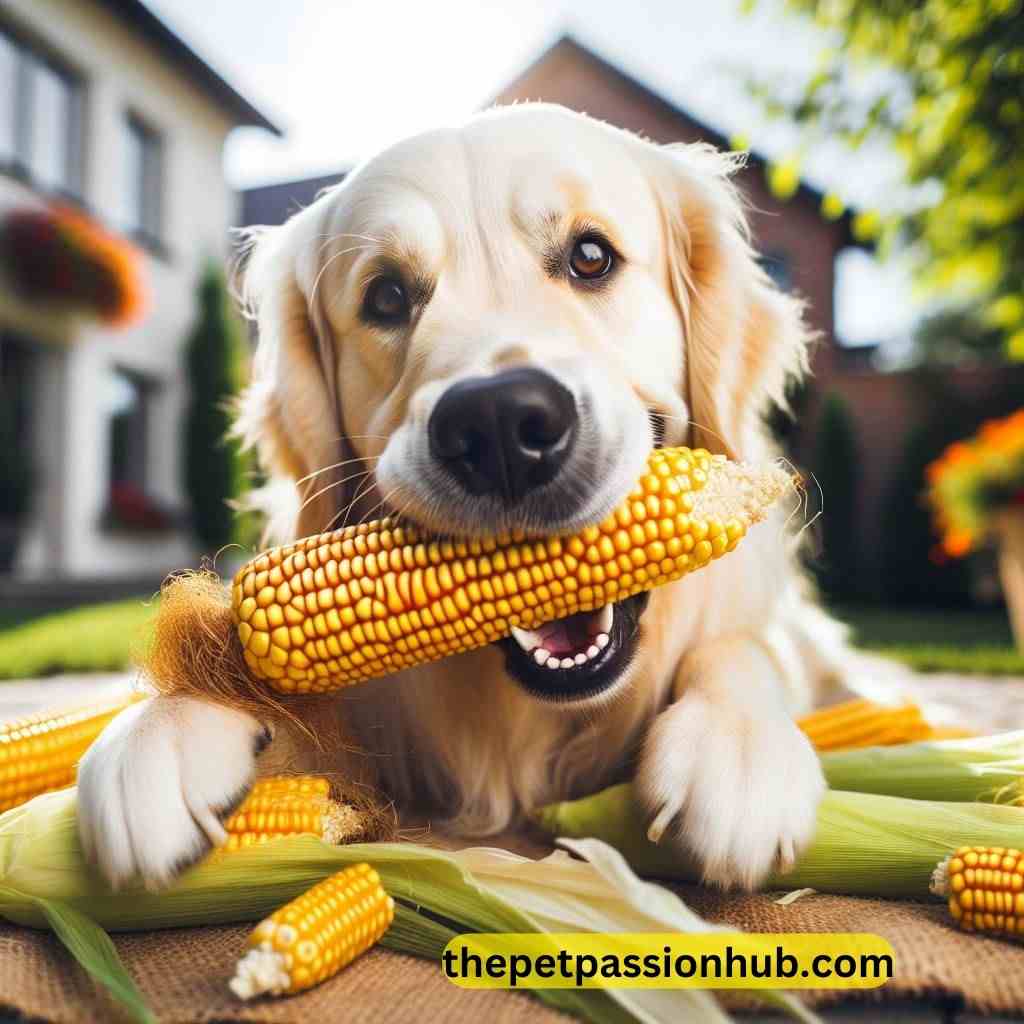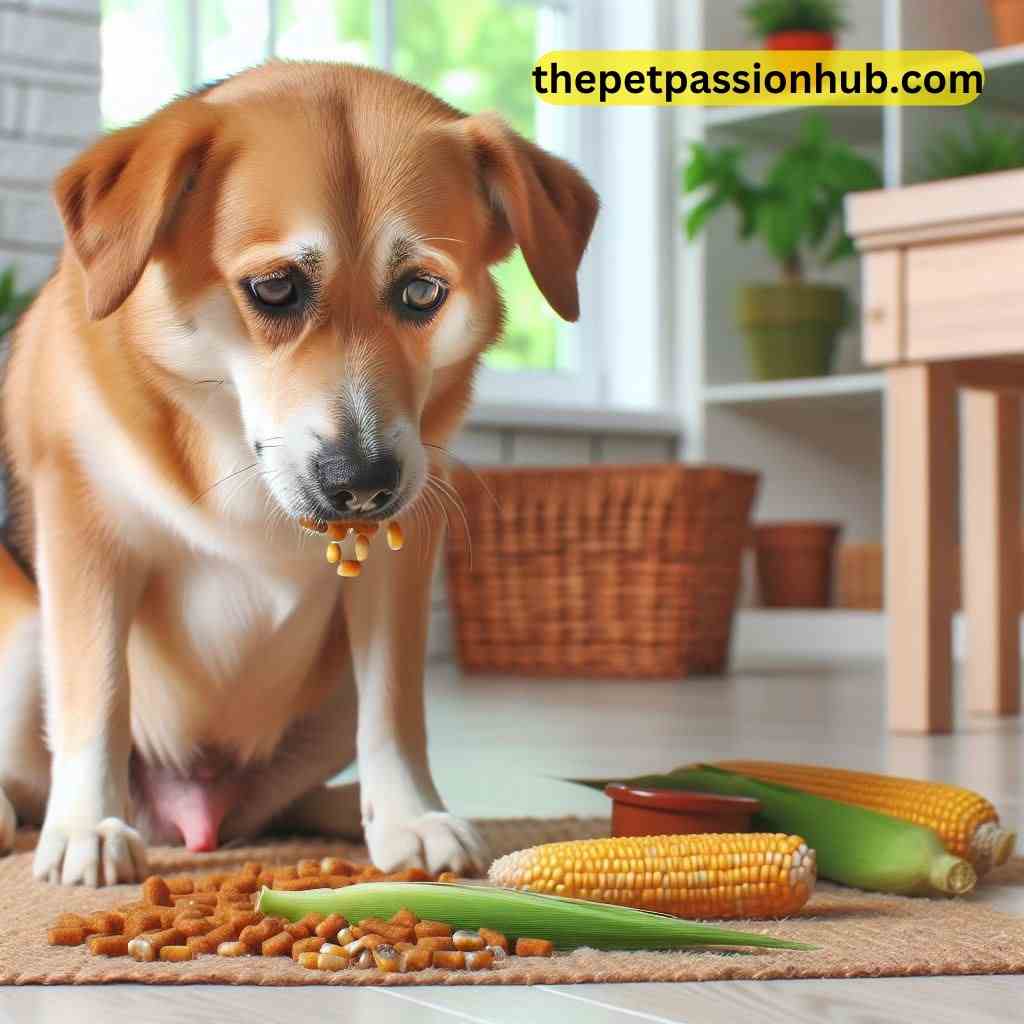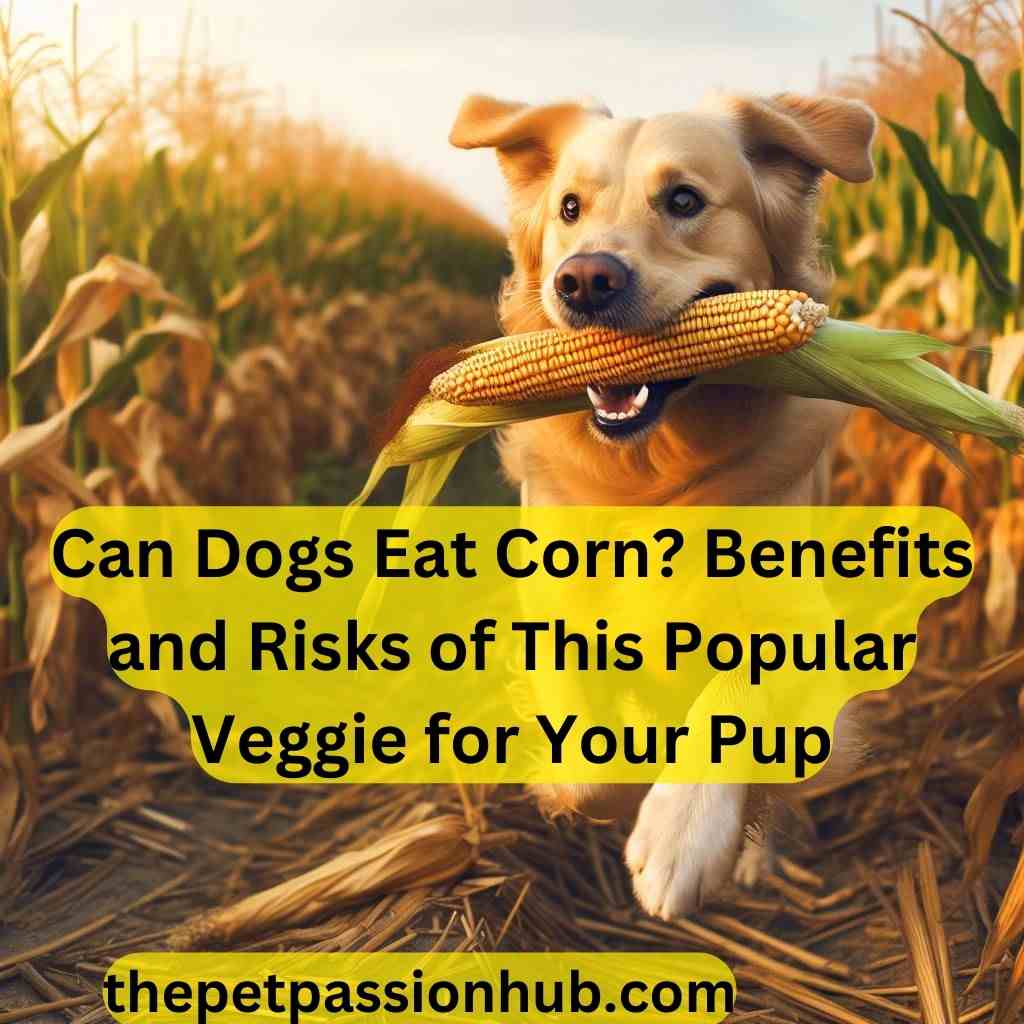Introduction
Corn: the classic American summer staple. From juicy corn on the cob straight off the grill to colorful stir fries and salsas, this sweet, crispy veggie is a warm weather favorite.
Our canine best friends watch us enjoy heaping piles of corn with begging eyes, assuming that they’d get a mouthwatering bite or two of this iconic summer food.
But can dogs eat corn in a nutritious and safe way? This is what many dog parents end up wondering, especially when their pups give them a pleading gaze at family barbecue time.
Well, the answer isn’t a simple yes or no. While corn can be fed to dogs in moderate amounts, there are some key things you should know first about the possible benefits and risks of this popular vegetable for your precious pup.
Tackling the question, “Can I give my dog corn or not?”, this article will clearly lay out guidelines on corn safety for dogs.

We’ll provide serving tips to optimize nutrition, as well as signs of trouble to watch for if your pet doesn’t tolerate it well.
The bottom line by the end: With smart precautions, corn can be shared as an occasional summer celebratory snack for dogs to nibble.
Perks and Positives: How Corn Can Help Your Furry Best Friend
When eaten in moderation, corn can actually be pretty nutritious for dogs. There are four main health benefits this sunny yellow vegetable offers to our canine companions. Let’s dig into the details on each one.
Promoting Digestive Regularly: Fiber Fuels Healthy Bowels
Corn packs a hefty punch of dietary fiber—around 18% of the daily value per cup! Both insoluble and soluble fiber types within corn provide substantial pooch poop perks.
Insoluble fibers like cellulose scrub the intestinal lining, moving digestion along at a healthy clip. Soluble fibers feed good gut bacteria, enabling gentle regularity. Together, they make corn a digestion-regulating powerhouse.
An occasional half-cob goes a long way toward combatting constipation by spurting stool volume. Too much too fast though and corn fibers could spur abrupt accidents or loose stool.
Introduce corn slowly, watching for any tummy trouble signs afterwards like vomiting or diarrhea before upping your dog’s dosage. In moderation over time, corn’s wealth of waist-whittling roughage promotes happy bowels in pets.
Vitamin C for Illness Immunity Strength
Unlike their human owners, man’s best friends don’t intrinsically create their own vitamin C supply like we do. This makes regularly receiving antioxidant-rich C from wholesome food sources critical.
Just a 70 gram ear of corn contains over 8 milligrams of immune-enhancing vitamin C your pup can’t live without for long.
Get this…that equals a whole entire orange worth! Low C in dogs shows in bleeding issues, pain, even tooth loss. Ensuring adequate vitamin C intake shields your pooch from such problems and improves their defenses against viruses.
Combine corn nibbles with other C-stacked foods like red peppers, leafy greens, even potatoes. This cocktail combats illness in pets of all breeds, sizes, ages and levels of activity by fueling resilience.
Linoleic Acid Hydrates Hair and Skin from Head to Paw
Another beneficial compound found in corn is linoleic acid—an anti-inflammatory omega-6 fatty acid.
Slightly oily, this chemical building block regenerates cell membranes on skin and coat surfaces when ingested. Linoleic acid smoothes, softens and hydrates hide layers often left dry, flakey or irritated by environmental factors like hot sun exposure or cold winter air.
Less dander-causing irritation also benefits indoor allergens. Between 6-10% of corn oil’s fatty acid content comes from biologically active linoleic acid.
Feed a quarter-cup of corn to a 50 pound pup and their body absorbs around 22-36 milligrams of helpful linoleic oil for skin and coat revitalization effects from nose to tail.
Energizing Carbs Fuel Play Power
Last but certainly not least, as a grain vegetable, corn kernels burst with starchy carbohydrate fuel. An entire cob packs nearly 30 grams of energizing complex carbs.
The glucose sugars released from corn digest slowly, avoiding sharp blood sugar spikes. Yet they steadily supply calories for sustained pep. The carb load provides pets the prolonged power surge to outrun, outplay and outlast their puppy peers.
It fuels those long, summer play date romps in the yard or park with no bonking mid-play. For athletic breeds like retrievers and collies focused on fetching, swimming and chasing toys, the big carb bank in corn prevents pooping out too fast.
It lets them reap all the joint-protecting, anxiety-relieving, immunity-lifting rewards of exercise longer without tuckering out early.
Hope this helps provide an expanded, more in-depth look at some of corn’s potential upsides for pups. Tailor the amount fed to your dog’s unique activity patterns, medical conditions, breed traits and weight goals.
Most importantly—observe how they personally process corn when initially introduced in tiny trial portions. Stop immediately if any concerning symptoms arise indicating individual intolerance.
Dangers and Downsides: Corn Caution Needed for Canines

Tricky to Digest: Don’t Overdo It
Some dogs lack sufficient amylase enzymes needed to properly break corn down, making it challenging to digest. Excessive portions overwhelm their gastrointestinal capacity.
Meat proteins digest slower with corn too, delaying stomach emptying. Eating too much corn too fast can therefore spark nasty nausea, vomiting, diarrhea or constipation.
Stomach-stuffing amounts also carry bloat risks, which can progress to deadly gastric torsion without quick treatment.
Signs of corn intolerance can include gassiness, abdominal cramping, bad breath and stool consistency changes.
Introduce corn slowly to allow your dog’s unique metabolism time to adapt. Dial back portions if adverse reactions emerge. Better to keep corn-based meals occasional rather than everyday.
Drug Interactions: Corn Could Offset Meds
Corn shouldn’t be mixed with certain medications prescribed to manage your dog’s medical conditions.
The antioxidants, vitamin K and linoleic fatty acids in corn can deactivate some drug therapies over time or impede absorption rates.
For example, corn lowers the efficiency of anti-seizure and heart medications by speeding their breakdown timeframe.
Check with your veterinarian about possible corn interactions before sharing any with a pet who takes routine medicines. Your vet can recommend proper timing and portions to avoid blocking benefits.
In some cases though, corn feeding should be avoided altogether based on pharmacokinetic interference risks.
Obesity Opportunities: Too Many Calories
It’s easy to unintentionally overfeed calorie-dense corn in excess. What seems like harmless snacking to us tall humans looks like endless feasts of fatty opportunity through our dogs shortened line of sight.
Just a half a cob packs nearly 100 calories…pile that into an already balanced kibble diet and obesity can strike.
Obese dogs experience joint issues, heart disease, diabetes, skin problems, breathing issues, spinal disc problems, ligament tears and certain types of cancer more often.
And losing weight is much harder for plump pooches compared to portly people thanks differences in metabolism and genetics. Keep corn around as a sporadic treat, avoiding tipping daily calorie scales into overfed territory.
Safety Starts With Cooking Properly
Feed only cooked corn to eliminate disease hazards from bacteria like E. coli or Salmonella that raw corn might harbor. Don’t let Fido eat right off just-picked cobs either before washing well, as field debris could cling to silks.
Salt, butter and oils make corn tastier for us, but prove toxic to doggy digestive systems unaccustomed to concentrated fats or sodium. Stick to plain air-popped or boiled corn with no heavy add-ons.
Whole kernel sizes present major choking risks for voraciously gobbling pets too. Chop before serving, or crush slightly with a food mallet. Cut corn neatly off the cob or stick to loose frozen or canned kernels instead. Safety first!
Hope these precautions around corn consumption help maximize benefits and avoid adverse effects. Always inspect your own dog’s individual tolerance carefully, adjusting portions to align with any reactions detected.
When in doubt if corn agrees well with your furkid or not, consult your trusted veterinarian for personalized feeding guidance.
Amazing Facts: Are Chicken Gizzards Safe For Dog?
How to Serve Corn Safely: Dos and Don’ts for Your Dog

Portion Control Priorities
When feeding corn, moderation metrics matter most. Limit nibbled kernels to occasional small snacks, not daily diet staples. An ear or two per week works as a general guide.
Cut back immediately if you notice any digestive upset or allergic signs afterwards like scratching, licking paws or skin changes.
Freezing then thawing remaining cooked corn in airtight bags makes perfect single-serve sizes. Defrost what you expect your dog will finish in one sitting, avoiding gorging over multiple days.
The right ration ranges vary by your dog’s weight. Consult your vet, but 25-50 grams of corn once or twice weekly per average pooch prevents overdoing calories.
Skip Seasonings and Oils
Resist the urge to slather corn-on-the-cob with butter, oils or salt before sharing! While we may savor buttery, salty richness, these add-ons prove toxic for canine constitutions.
Stick to plain air-popped, grilled or lightly steamed corn with nothing extra. Oils, dairy and sodium burden doggy digestive tracts not biologically wired to handle concentrates of fat, lactose or minerals well.
Over time, these spur pancreatitis, kidney damage and stomach tumors. Play it safe by keeping corn au natural. Air pop it dry, grill it bare or steam it solo.
Chop Chop! Cut Kernels Down
Another safety step includes chopping corn kernels into mini nibbles before serving. Whole kernels pose major choking hazards for voraciously eager eaters who barely chew before swallowing big gulps. Cut corn off the cob then dice into pea-sized bits.
Choose loose frozen or canned niblets too for less slicing labor. If you must serve cobs, hold them yourself, allowing only small bite access. This prevents dangerous whole kernel blockages from forming. And it also helps pace gobblers, extending enjoyment.
Blend with Familiar Favorites
Try mixing a few spoonfuls of corn in with your dog’s existing kibble or canned cuisine first.
Combining corn with previous preferred proteins and flavors they associate with normal nosh times prevents digestive issues triggered by abrupt food rotations.
It also masks corn’s flavor in case your furry friend finds it strange initially. Dogs tend to eagerly wolf whatever semi-moist mix you present at feeding time.
So blending corn with former favorites makes acceptance easier while allowing you to spot any worrisome reactions right away. From there, gauge tolerability, slowly adjusting ratios.
Care, safety and moderation combining corn into your canine’s menu leads to happy, healthy pups able to enjoy summer’s signature veggie safely! Follow these tips and pay attention to any reactions afterwards. Consult your vet with any concerns.
6 Approved Facts. “How Much Avocado Will Kill A Dog?”
The Final Verdict: Corn Can Be Canine-Safe
When eaten properly, corn offers some nutritional benefits and enjoyment to dogs as the occasional snack.
In moderation, corn provides added fiber for digestion, vitamin C for immunity, skin/coat perks from linoleic acid and an energy boost from carbs.
However, excessive portions can lead to obesity or stomach issues in pets not wired to process corn easily.
Make sure corn is always cooked, cut small, plain and gradually transitioned into your dog’s diet while monitoring them for individual tolerance.
The main takeaway for dog owners about corn: yes, you can safely feed this summer staple veggie to your furry best friend! But stick to recommendations around preparation, portion control and monitoring your pup’s personal reaction.
When introducing new human foods like corn to your dog, start slow and small under supervision first.
Pay attention to any concerning symptoms afterwards like vomiting, diarrhea, excessive gas or abdominal pain/bloating as potential signs of intolerance.
Stop feeding corn immediately if these signal an individual inability to properly digest it.
Otherwise, corn can become a beloved seasonal snack your dog looks forward to! Just don’t overdo servings. Ultimately finding the right balance comes down to carefully observing your dog’s unique responses.
Let your own pet be the judge through cautious corn trial time. Gauge their personal enjoyment and aftermath, tweaking amounts align with tolerance.
If you have any concerns about corn risks given your dog’s breed, age or medical status, consult your veterinarian to determine appropriate feeding advice. Here’s to happily sharing the summer spirit with dogs!
